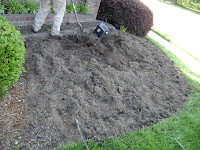With the return of warmer weather, many of us are out in the yard, sprucing up our landscapes, creating beautiful surroundings to enjoy as we spend time outside with our neighbors, family, and friends. Planting annual flowers are one way to continue that jolt of color that we see in the early spring from the beautiful yellow forsythias and colorful tulips that announce the arrival of spring. When planting annual flower beds, there are some things to keep in mind.
- Plan before you plant… When picking the flowers for your bed, do the research to find out the plants' sunlight and water needs. If you put a shade-loving plant in a sunny spot, or a sun-loving plant in a shady spot, you will end up with a flower that is struggling to survive.
- Proper soil preparation is key. In our area, we have heavy clay soil which holds water and is very dense. It makes it hard for roots to penetrate. (I pity the roots. I almost threw my back out trying to dig a hole in my backyard. It's like digging through concrete!) It is best to till and amend the planting bed with soil conditioner that contains pine bark fines or compost before starting. At AA Tex Lawn, we shy away from using potting mixes that contain peat. While peat loosens the soil, it also holds water and decomposes quickly. Since clay soil holds water naturally, amending with something that retains water can lead to your flowers getting too much water. Secondly, peat is not a sustainable resource. Since peat beds take thousands of years to form, it is not possible to renew them as quickly as we use them. That is why we try to stick to soil conditioners that contain pine bark fines. You should be able to find these at your local retail store. Raising the bed 2 to 3 inches will also help with drainage.


As a homeowner, I know sometimes we don't have the time, resources, and equipment to spend on bed prep before we begin the planting process. Keep in mind, though that beginning with the right soil conditions can make all the difference in how the flowers prosper. But, what if you don't own or want to rent a tiller? Or don't have the energy to turn the soil of the bed with a shovel? Even if you don't till and amend the whole bed before planting, be sure to incorporate a compost or soil conditioner equally with the soil from the hole you've dug. It will provide a softer soil to encourage root growth as well as help with drainage. Depending on the type of plants you are installing, you may also want to add other amendments to customize the soil for the plants' particular needs.
- Fertilize your beds at installation with a long lasting, slow release fertilizer to provide nutrients throughout the growing season. For most annual beds, it is OK to use a good, balanced fertilizer with similar numbers such as a 14-14-14 N-P-K ratio. Your local retail store may sell fertilizers or potting mix/fertilizer combinations that are optimized for a particular plant type. (i.e. orchids, African violets, etc.)
- As for spacing, follow the instructions on the tag that came with your plants to leave room for mature plant size. Each distinct variety within a species may grow to a different height and width.
- Water in your new plants thoroughly. This serves several purposes. It settles any air pockets left in the soil after the planting; be sure to backfill any settling that occurs with additional soil or conditioner mix. Watering enough to soak the roots also helps alleviate the stress the plant goes under when moving to a new location. Water regularly (every couple of days) for the first couple of weeks.
- When done, mulch around the flowers with soil conditioner or the smallest pine bark you can find. These natural, organic mulches will renew the soil as they decompose and give your bed a head start for the next planting.
With the right conditions and water, the plants in your bed should thrive and bloom beautifully for you all summer long. For more information on annual flower beds or if you want our help in installing them, give us a call at our office at 704-821-0708 or visit
http://www.aatexlawn.com/.
Thanks,
The AA Tex Lawn Team

 Grubs will feed a little bit in the late spring before turning into their adult stage beetle. Typically you see most grub damage in the months of September and October. Putting down an insecticide at the right time can help reduce damage to your lawn from the beetles. The most common beetle we encounter is the Japanese beetle. As you probably know, Japanese beetles will attack your shrubs in June. If you have a nice lawn and notice a lot of Japanese beetles in your plants this summer, there is a good chance you could have an infestation of grubs. Beetles will lay their eggs in thick healthy lawns so that they can properly feed before burrowing deep in the soil for the winter.
Grubs will feed a little bit in the late spring before turning into their adult stage beetle. Typically you see most grub damage in the months of September and October. Putting down an insecticide at the right time can help reduce damage to your lawn from the beetles. The most common beetle we encounter is the Japanese beetle. As you probably know, Japanese beetles will attack your shrubs in June. If you have a nice lawn and notice a lot of Japanese beetles in your plants this summer, there is a good chance you could have an infestation of grubs. Beetles will lay their eggs in thick healthy lawns so that they can properly feed before burrowing deep in the soil for the winter. 





